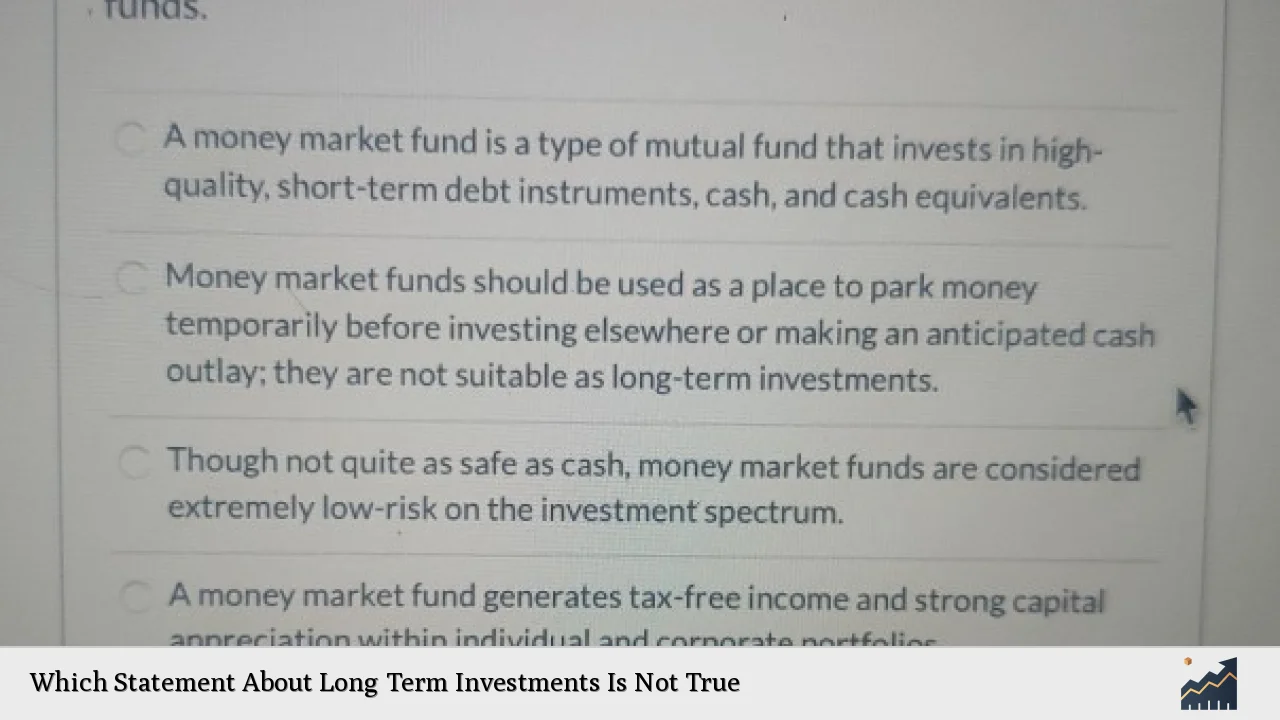Long-term investments are a critical component of financial planning and wealth accumulation. Understanding the truths and myths surrounding these investments can significantly impact individual investors’ strategies and outcomes. This article aims to clarify common misconceptions about long-term investments, particularly focusing on which statements about them are not true.
| Key Concept | Description/Impact |
|---|---|
| Long-term Investment Duration | Long-term investments are typically held for more than one year, allowing investors to ride out market volatility and benefit from compound growth. |
| Usage in Business Operations | Long-term investments are generally not used in day-to-day business operations but are held for future appreciation or income generation. |
| Inclusion of Cash Accounts | Cash accounts are typically not classified as long-term investments; they are considered current assets due to their liquidity. |
| Diversity of Assets | Long-term investments can include stocks, bonds, real estate, and other assets intended for long-term appreciation or income. |
Market Analysis and Trends
In recent years, the landscape of long-term investing has evolved significantly due to various economic factors. The S&P 500 index, a benchmark for U.S. equities, has shown substantial growth, rising by approximately 27% over the past year. This trend underscores the importance of maintaining a long-term perspective in investment strategies.
Current Market Trends
- Technological Advancements: The rise of artificial intelligence has driven significant market gains, particularly in technology stocks.
- Inflation and Interest Rates: With inflation rates stabilizing, many investors are looking towards fixed-income securities as a hedge against potential economic downturns.
- Global Economic Conditions: Economic growth is expected to slow down in the coming quarters, prompting investors to reassess their portfolios.
Implementation Strategies
To effectively leverage long-term investments, individuals should consider several strategies:
- Diversification: Investing across various asset classes can mitigate risks associated with market volatility. A well-diversified portfolio typically includes equities, fixed income, real estate, and alternative investments.
- Dollar-Cost Averaging: This strategy involves consistently investing a fixed amount over time, regardless of market conditions. It helps reduce the impact of volatility by averaging out purchase costs.
- Regular Portfolio Review: While long-term investing requires patience, regularly reviewing and rebalancing your portfolio ensures alignment with financial goals and risk tolerance.
Risk Considerations
Investing always carries risks, but understanding these can help mitigate potential losses:
- Market Risk: The possibility that an investment’s value will decline due to market fluctuations. Long-term investors can often ride out these fluctuations.
- Interest Rate Risk: Changes in interest rates can affect bond prices and other fixed-income investments. As rates rise, bond prices typically fall.
- Inflation Risk: Over time, inflation can erode purchasing power. Long-term investments should ideally provide returns that outpace inflation.
Regulatory Aspects
Understanding regulatory frameworks is essential for long-term investors:
- SEC Regulations: The U.S. Securities and Exchange Commission (SEC) oversees securities transactions to protect investors. Familiarity with these regulations can help in making informed investment decisions.
- European Long-Term Investment Fund (ELTIF): Recent updates to the ELTIF regulations aim to enhance investment opportunities while ensuring investor protection through strict compliance measures.
Future Outlook
Looking ahead, several factors will shape the future of long-term investing:
- Sustainable Investing: There is a growing trend towards environmental, social, and governance (ESG) criteria influencing investment decisions. Investors are increasingly considering sustainability as a key factor in their portfolios.
- Technological Integration: Advancements in fintech will likely enhance investment accessibility and efficiency, enabling more individuals to participate in long-term investing.
- Global Economic Shifts: As economies recover from recent disruptions, shifts in global markets may present new opportunities for long-term growth.
Frequently Asked Questions About Long Term Investments
- What is considered a long-term investment?
A long-term investment is typically held for over one year and includes assets like stocks, bonds, real estate, and mutual funds. - How do I determine my risk tolerance?
Assess your financial situation, investment goals, and how you react to market fluctuations to determine your risk tolerance. - Is diversification necessary for long-term investing?
Yes, diversification reduces risk by spreading investments across various asset classes. - What are the tax implications of long-term investments?
Long-term capital gains are usually taxed at a lower rate than short-term gains; understanding these implications can enhance tax efficiency. - Can I lose all my money in long-term investments?
While it’s possible to incur losses, especially if you invest in high-risk assets without proper research or diversification, a well-planned strategy mitigates this risk. - How often should I review my long-term portfolio?
Regular reviews—typically annually—are recommended to ensure your portfolio aligns with your financial goals and market conditions. - What role do economic indicators play in long-term investing?
Economic indicators like GDP growth rates and unemployment levels provide insights into market conditions that can influence investment strategies. - Should I consult a financial advisor for long-term investments?
Yes, consulting a financial advisor can provide personalized guidance based on your unique financial situation and goals.
This comprehensive analysis highlights that understanding the truths about long-term investments is crucial for successful financial planning. By debunking common myths and providing actionable strategies along with current market insights, investors can make informed decisions that align with their financial goals.

